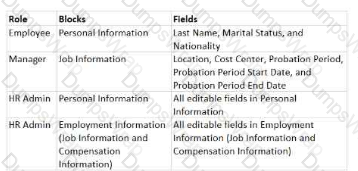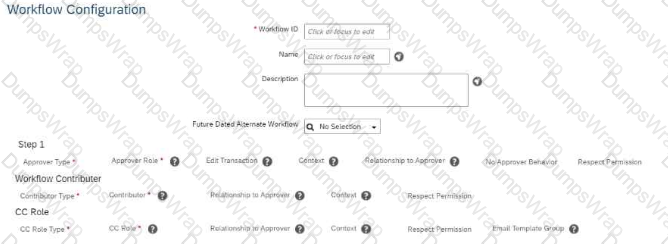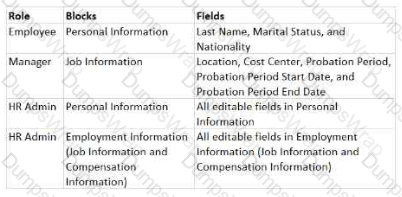SAP Certified Application Associate - SAP SuccessFactors Employee Central Core 2H/2023 Questions and Answers
Your customer would like to automate its company's HR transactions. This includes auto-populating fields to reduce data entry errors and automating approvals during self-service transactions.
You are asked to create the following rules based on your customer's requirements:
• Three event reason derivation rules (ERD1, ERD2, ERD3)
• A separate catch-all event reason derivation rule (ERD-Catch)
• A workflow derivation rule based on event reasons (WFD)
• A rule to auto-populate the Job Title, Pay Grade, and Employee Class field values in the Job Information whenever the job code is changed • A rule to use AddressChange workflow for any address change requests (WFD_Address) • A cross-entity rule to auto-calculate the Base_Salary amount based on changes to the FTE value for any event other than Hire or Rehire (Joblnfo_FTE_Comp) Answer the questions to ensure the event reasons and workflow rules adhere to SAP SuccessFactors recommended practices. Which condition must be used for the JobInfo_FTE_Comp rule? A) B) C) D)



Which objects are supported in cross-entity business rules? Note: There are 2 correct answers to this question.
Which method of modifying employee data will trigger an event reason derivation?
What does SAP SuccessFactors recommend when you create custom associations between foundation objects (FO)?
You have updated several position departments using Import and Export data, but the incumbent's data still shows the previous information for the department hris-field. What are some possible causes for this data inconsistency? Note: There are 2 correct answers to this question.
You want the Timezone field to be pre-populated when the location record is changed in Job Info. How do you configure this?
The manager has the ability to change the salary during the workflow. Which of the following options do you need to select for a new workflow to be triggered when the manager edits the salary?
You need to create a one-to-many association from Location to Legal Entity. You also need to configure filtering of the Location field based on the Company field in the Job Information block. What do you need to add to the data models? Note: There are 2 correct answers to this question.
Which events are NOT supported by event reason derivation? Note: There are 2 correct answers to this question.
Which of the following are possible options when working with SAP SuccessFactors Employee Central employee identifiers? Note: There are 3 correct answers to this question.
Your customer would like to automate its company's HR transactions. This includes auto-populating fields to reduce data entry errors and automating approvals during self-service transactions.
You are asked to create the following rules based on your customer's requirements:
• Three event reason derivation rules (ERD1. ERD2. ERD3)
• A separate catch-all event reason derivation rule (ERD-Catch)
• A workflow derivation rule based on event reasons (WFDJ
• A rule to auto-populate the Job Title, Pay Grade, and Employee Class field values in the Job Information whenever the job code is changed (Default_JobClass)
• A rule to use AddressChange workflow for any address change requests (WFD_Address)
• A cross-entity rule to auto-calculate the Base_Salary amount based on changes to the FTE value for any event other than Hire or Rehire (Jobinfo_FTE_Comp)
Answer the questions to ensure the event reasons and workflow rules adhere to
How do you set the event date in Compensation Information for the JobInfo_FTE_Comp cross-entity rule?
A)

B)

C)

D)

Which of the following are examples of standard one-to-one associations? Note: There are 2 correct answers to this question.
Which object supports &&NO_OVERWRITE&& in imports? Note: There are 2 correct answers to this question.
Which fields are required when importing Personal Information? Note: There are 2 correct answers to this question.
What field of the country-specific Corporate Address element is required in the Corporate Data Model?
Your customer would like to automate its company's HR transactions. This includes auto-populating fields to reduce data entry errors and automating approvals during self-service transactions.
You are asked to create the following rules based on your customer's requirements:
• Three event reason derivation rules (ERD1, ERD2, ERD3)
• A separate catch-all event reason derivation rule (ERD-Catch)
• A workflow derivation rule based on event reasons (WFD)
• A rule to auto-populate the Job Title, Pay Grade, and Employee Class field values in the Job Information whenever the job code is changed (Default_JobClass)
• A rule to use AddressChange workflow for any address change requests (WFD_Address)
• A cross-entity rule to auto-calculate the Base_Salary amount based on changes to the FTE value for any event other than Hire or Rehire (Jobinfo_FTE_Comp)
Answer the questions to ensure the event reasons and workflow rules adhere to SAP SuccessFactors recommended practices.
Which rule can effectively catch all unspecified events in a transaction?
A)

B)

C)

D)

The employee is changing their marital status. Once the workflow is approved, the manager gets a notification via e-mail that this change has been processed. The manager then goes into the system and checks the workflow, but notices that they can see more fields than the ones for which they should receive a notification (Name, Marital Status, and Nationality). Why is that?
Which steps are required to set up the Auto Delegation feature for a workflow in Employee Central? Note: There are 2 correct answers to this question.
Your customer would like to automate its company's HR transactions. This includes auto-populating fields to reduce data entry errors and automating approvals during self-service transactions.
You are asked to create the following rules based on your customer's requirements:
. Three event reason derivation rules (ERD1. ERD2, ERD3)
• A separate catch-all event reason derivation rule (ERD-Catch)
• A workflow derivation rule based on event reasons (WFD)
• A rule to auto-populate the Job Title, Pay Grade, and Employee Class field values in the Job Information whenever the job code is changed (Default_JobClass)
• A rule to use AddressChange workflow for any address change requests (WFD_Address)
• A cross-entity rule to auto-calculate the Base_Salary amount based on changes to the FTE value for any event other than Hire or Rehire (Joblnfo_FTE_Comp)
Answer the questions to ensure the event reasons and workflow rules adhere to SAP SuccessFactors recommended practices.
Which rule supports the Default_JobClass requirement?
A)

B)

C)

D)

In which entities is Alert Notification supported? Note: There are 2 correct answers to this question.
What must be done to ensure that you can use a custom generic (MDF) object for Employee Self-Service? Note: There are 2 correct answers to this question.
You nave a global customer who has legal entities in multiple countries The customer wants to empower employees and managers to use the system, so they have decided to implement Employee Self-Service and Manager Self-Service The customer also has payroll integration with different systems, and for some countries, the data is manually maintained in the payroll system
The requirements are as follows
Employees should be able to update their Personal Information, including Last
Name Marital Status, and Nationality fields
Managers should be able to update Job Information on the employee's profile, but limited only to Location. Cost Center. Probation Period. Probation Period Start
Date: and Probation Period End Date.
Only HR admins should have access to approve the workflows, and the manager should only get CC notifications for Personal Information (Name Marital Status, and Nationality change) For all other changes, the manager should not get any information or notification
HR admins should be able to change Personal information as well as Employment
Information, and the HR Business Partner needs to approve these. If the HR admin needs to change the Compensation Information approval will need to be granted by their own manager For one country, there needs to be another approval from the data team who will manually maintain the payroll system
The table below summarizes the permissions for each role:


Due to confidentiality reasons, when the HR Business Partner (maintained in Job Relationship) is creating a change in salary for an employee, this action will need to be approved by the manager of the HR Business Partner creating the request. How do you define this in the workflow when filling in the Approver Type, Approver Role, Context, and Relationship to Approver? Refer to the screenshot to answer the question.
You have a global customer who has legal entities In multiple countries The customer wants to empower employees and managers to use the system, so they have decided to implement Employee Seif-Service and Manager Self-Service The customer also has payroll integration with different systems, and for some countries, the data is manually maintained In the payroll system
The requirements are as follows
• Employees should be able to update their Personal information, including Last Name. Marital Status, and Nationality fields
• Managers should be able to update Job information on the employee's profile but limited only to Location. Cost Center. Probation Period. Probation Period Start Date, and Probation Period End Date
• Only HR admins should have access to approve the workflows, and the manager should only get CC notifications for Personal Information (Name. Marital Status, and Nationality change) For all other changes, the manager should not get any information or notification
• HR admins should be able to change Personal Information as well as Employment information, and the HR Business Partner needs to approve these If the HR admin needs to change the Compensation Information approval will need to be granted by their own manager
• For one country, there needs to be another approval from the data team who will manually maintain the payroll system.
The table below summarizes the permissions for each role:

An employee will be changing their nationality information on their own. How do you build the IF condition in the business rule so they can do this?
A)

B)

C)

D)

What base object must you use for the JobInfo_FTE_Comp rule?

